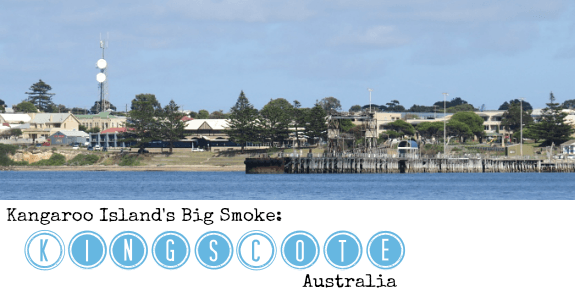Kingscote, Kangaroo Island
/ Half of Kangaroo Island's population of 4,000 people live in the vicinity of Kingscote. It's the commercial and shopping hub of the island. We motored the 15 miles or so in flat calm waters from Eastern Cove and anchored off the port. After confirming that 1) there were still no rental cars available and 2) we were too late to go on a tour, we decided lunch in town and a walk around Kingscote would have to do.
Half of Kangaroo Island's population of 4,000 people live in the vicinity of Kingscote. It's the commercial and shopping hub of the island. We motored the 15 miles or so in flat calm waters from Eastern Cove and anchored off the port. After confirming that 1) there were still no rental cars available and 2) we were too late to go on a tour, we decided lunch in town and a walk around Kingscote would have to do.
A rather odd thing happened as we were hauling anchor in Eastern Cove. A bee flew in from the island and landed on the windscreen. I saw him and thwacked him off with a snap of my fingers. He flew back and landed a few feet away. I thwacked him again. And again, he moved a few feet away and landed. I figured he was interested in a lift to Kingscote to visit friends and family or look for work and keen to find a ride. The third time, I let him rest. I read that the Ligurian bees on Kangaroo Island are quite famous and unique … who was I to mess with insect fame?
Kingscote boasts that it's the first official European settlement in South Australia. The British barque Duke of York anchored in Nepean Bay on July 27, 1836 and established Reeves Point as a formal settlement. The Visitor Info kiosk is part of the KI souvenir shop and a Kingscote brochure was easily obtained. There were several walking tours described, but the best was a 4km walk along the beach to historic Reeves Point with lots of historic info placards strategically placed along the way.
We walked along a boardwalk through a protected blue penguin (aka little penguin) reserve. Penguins are nocturnal and this happens to be breeding season, so nobody was at home, but we did see their little fabricated huts along the tufted hillside.
It was the bottom of the low tide as we walked along the shore, traipsing through shells and debris along the wrack line. I found several pieces of well worn sea glass to add to my “I'll do something constructive with it later” collection. We passed the remains of old jetties, lost long ago to wind, sea and weather, a few errant pilings the only reminders of their existence.
At Reeves Point, we headed up to Flagstaff Hill for better views of the bay. En route, we came across The Mulberry Tree, originally planted in 1836 by the first settlers. It has some support nowadays to keep it upright, but it still purportedly bears fruit each year.
The climb to Flagstaff Hill wasn't difficult, it's not that high, but the panoramic views were indeed lovely. We saw the foundations of old home sites along the way and thought the early settlers definitely had a rough time of it, but their choice of house locations were spot on.
Back to town via the original settlers' cemetery. This is always an interesting stop for us. We learn so much from the epitaphs and gravestones. The children seemed to have the worst time here … sickness, starvation, accidents, all noted on the gravestones. People who died en route and were buried at sea were remembered, as well as those who died in the early years of settlement.
We returned to Kingscote via the Esplanade, high above the shore. Nine of Cups bobbed gently in the waves, her wind gen spinning smartly, toting up amps, so we could watch a movie this evening. A fine day, perhaps not as much as we'd hoped for our time here, but sometimes we take what we can get.
Back to our Ligurian bee hitchhiker … he flew off just as we anchored at Kingscote, obviously figuring he could make his own way from there. We bought some KI honey in his honor.








